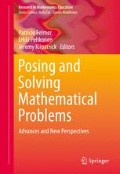Abstract
Learning by experience is of essential importance in everyday life and also in the academic field. Academically engaging with experience can be called induction or inductive reasoning, which Klauer explains as “recognising regularity or order in the only apparently non-ordered while giving awareness to disruptions or non-order in the only apparently ordered” (Klauer, 1991, p. 137; translated by T.F.). Even if it might seem surprising, induction according to Pólya plays an important role especially in mathematics:
Access this chapter
Tax calculation will be finalised at checkout
Purchases are for personal use only
Notes
- 1.
American philosopher and mathematician Charles Sanders Peirce distinguishes in this context between induction and abduction.
- 2.
The pattern supposed by John cannot be reconstructed. For a 4 × 5 rectangle , there are seven points of intersection.
- 3.
Indeed, Liam is not yet sure regarding the universality of the pattern assumed (cf. the following remarks).
- 4.
And therefore visualized lighter in Fig. 3
References
Borel, A. (1984). Mathematik: Kunst und Wissenschaft (2nd ed.). München, Germany: Carl Friedrich von Siemens Stiftung.
Chazan, D. (1990). Quasi-empirical views of mathematics and mathematics teaching. Interchange, 21(1), 14–23.
Fritzlar, T. (2010). “Investigations” und Explorationen in der Elementarmathematik. Der Mathematikunterricht, 56(3), 3–13.
Fritzlar, T., Rodeck, K., & Käpnick, F. (2006). Mathe für kleine Asse. 5./6. Schuljahr. Berlin, Germany: Cornelsen.
Hadamard, J. (1949). An essay on The Psychology of Invention in the mathematical field. New York: Dover.
Heintz, B. (2000a). Die Innenwelt der Mathematik: Zur Kultur und Praxis einer beweisenden Disziplin. Wien, Austria: Springer.
Heintz, B. (2000b). “In der Mathematik ist ein Streit mit Sicherheit zu entscheiden”: Perspektiven einer Soziologie der Mathematik. Zeitschrift für Soziologie, 29(5), 339–360.
Klauer, K. J. (1991). Erziehung zum induktiven Denken: Neue Ansätze der Denkerziehung. Unterrichtswissenschaften, 19(2), 135–151.
Lakatos, I. (1976). Proofs and refutations: The logic of mathematical discovery. Cambridge, England: Cambridge University Press.
Leuders, T., Naccarella, D., & Philipp, K. (2011). Experimentelles Denken—Vorgehensweisen beim innermathematischen Experimentieren. Journal für Mathematikdidaktik, 32(2), 205–231.
Philipp, K. (2013). Experimentelles Denken: Theoretische und empirische Konkretisierung einer mathematischen Kompetenz. Wiesbaden, Germany: Springer Spektrum.
Pólya, G. (1954a). Mathematics and plausible reasoning: Vol I: Induction and analogy in mathematics. Princeton, NJ: Princeton University Press.
Pólya, G. (1954b). Mathematics and plausible reasoning: Vol. 2: Patterns of plausible inference. Princeton, NJ: Princeton University Press.
Pólya, G. (1962). Mathematical discovery: On understanding, learning, and teaching problem solving (Vol. I). New York: Wiley.
Pólya, G. (1971). How to solve it (2nd ed.). Princeton, NJ: Princeton University Press.
Putnam, H. (1979). What is mathematical truth? In H. Putnam (Ed.), Mathematics, matter and method (2nd ed., pp. 60–78). Cambridge, MA: Cambridge University Press.
Strauss, A. L., & Corbin, J. M. (1990). Basics of qualitative research: Grounded theory procedures and techniques. Thousand Oaks, CA: Sage.
Author information
Authors and Affiliations
Corresponding author
Editor information
Editors and Affiliations
Rights and permissions
Copyright information
© 2016 Springer International Publishing Switzerland
About this chapter
Cite this chapter
Fritzlar, T. (2016). “Memorable Diagonals”: Exploratory Problems as Propositions for Doing Mathematics. In: Felmer, P., Pehkonen, E., Kilpatrick, J. (eds) Posing and Solving Mathematical Problems. Research in Mathematics Education. Springer, Cham. https://doi.org/10.1007/978-3-319-28023-3_10
Download citation
DOI: https://doi.org/10.1007/978-3-319-28023-3_10
Published:
Publisher Name: Springer, Cham
Print ISBN: 978-3-319-28021-9
Online ISBN: 978-3-319-28023-3
eBook Packages: EducationEducation (R0)

